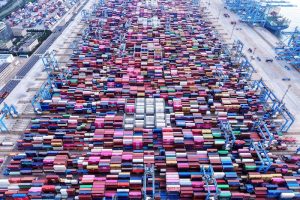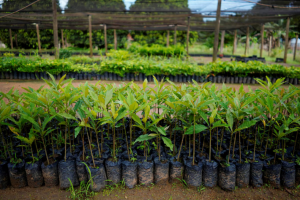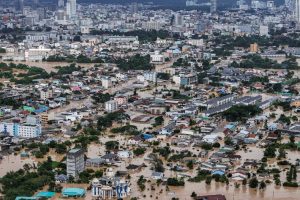Extreme weather events related to climate change have led to economic losses of more than $30 billion for China in the third quarter of the year.
The world’s second-largest economy faced super typhoons and floods from record rainfalls between July and September, leading to cumulative damages of 230 billion yuan ($32.3 billion), according to Reuters calculations based on nine-month data released by the Ministry of Emergency Management on Tuesday.
That was more than double the 93.16 billion yuan worth of losses from such events in the first six months of the year.
Also on AF: At COP16, Officials Push to Align Nature And Climate Goals
The rising losses speak to China’s increasing vulnerability to climate change, with warming temperatures magnifying the intensity of storms and rainfall hitting the region.
In September, China’s financial hub Shanghai was brought to a standstill by Typhoon Bebinca, the most powerful tropical cyclone to directly hit the city in 70 years.
That was after, Super Typhoon Yagi – the strongest typhoon on record – tore through Hainan city that same month, knocking down power supply to nearly 1 million households in the province.
Overall, direct economic losses in the first three quarters stood at 323.2 billion yuan, higher than 308.3 billion yuan a year earlier, according to the ministry’s data.
Record rainfall and powerful typhoons affected more than 84 million people during the period. The number of people dead or missing totalled 836, while nearly 3.35 million people needed to be resettled, data showed.
Meanwhile, 630,000 homes were damaged, while 50,000 collapsed.
Freak weather events also disrupted supplies of foodstuffs, raising consumer prices and dampening agricultural output. About 9.05 million hectares of crops were impacted during the period.
Long way to climate resilience
The emergency management ministry said the natural disasters this year were “complex and severe”, with relief work facing great challenges.
Some 23 disaster relief responses have been initiated, it said, the most in nearly a decade.
China is particularly prone to extreme weather caused by climate change due to the country’s 32,000km-long coastline, which is home to trillions of dollars worth of commercial activity.

In July, China’s meteorological agency warned the country faces hotter and longer heatwaves and more frequent and unpredictable heavy rain as a result of climate change.
The agency said if carbon emissions remain high, extreme heat events expected to occur once every 50 years in China could happen every other year by the end of the century, and rainfall could double and become more unpredictable.
With winter approaching, the country’s weather is also likely to shift from warm to freezing in the next two months. Last year, temperatures broke a 64-year-old record in China’s far western region of Xinjiang, plunging to a bone-chilling minus 52.3 degrees Celsius.
The increasingly disruptive weather has deepened the cost to China’s economy.
The country launched a nationwide adaptation strategy more than two years ago, pushing for better monitoring and prediction of extreme weather, and a building of resilience in the agriculture industry, infrastructure and urban environment.
But losses this year show China has still to a long way to go to become sufficiently resilient to climate change.
Meanwhile, Beijing has also sought trillions of dollars in climate finance from wealthy nations in complex ongoing negotiations.
The country has described itself as one of the world’s most climate-vulnerable countries, while also citing higher per-capita historical emissions of developed countries.
- Reuters, with additional editing and inputs from Vishakha Saxena
Also read:
Hundreds of Billions for Climate Change Seen as ‘Realistic Goal’
Scientists Fear Nature’s Carbon Sinks Are Failing – Guardian
Floods or Drought: Climate Change Worsens Global Water Woes
Global Wind Turbine Demand Soars on China Energy Push
China Coal Output Rises But Power Generation Use Declines
China Turns to Carbon Capture, Biomass For Coal Power Emissions
Climate Change ‘Fuelled’ Rain That Led to Fatal Indian Landslides
Energy Emissions Set to Peak But ‘Not in Time’ For Climate Goals
























